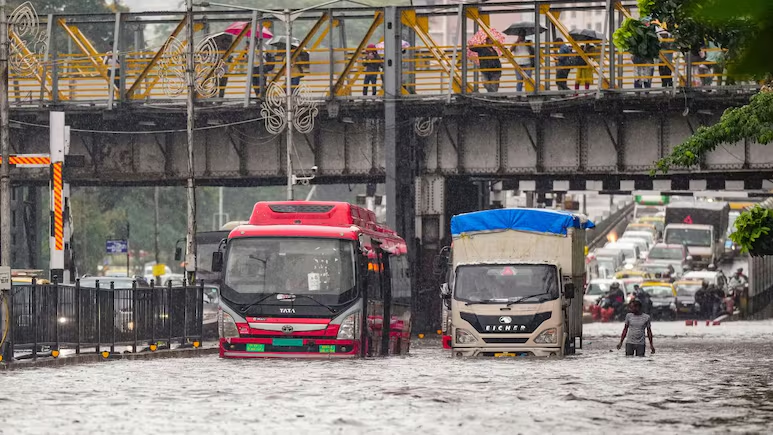Why can’t Mumbai fix its flooding issues during heavy rains each year?
Mumbai’s Monsoon Misery: Unraveling the Annual Deluge

Why Mumbai Monsoon Ends In A Flood
Table of Contents
Every year, as the monsoon clouds gather over Mumbai, the city braces for an all-too-familiar ordeal: flooded streets, stranded commuters, and submerged infrastructure. Social media fills with images of waterlogged roads, swamped railway tracks, and even newly built metro stations succumbing to the relentless rain. Despite the recurring chaos, the underlying causes remain stubbornly unresolved. This blog delves into the intricate reasons behind Mumbai’s annual flooding, exploring the city’s geography, infrastructure challenges, and changing climate patterns.
Mumbai Monsoon : A City at the Mercy of Tides
Mumbai’s drainage system is intricately tied to the rhythms of the Arabian Sea. The city’s stormwater drains, designed to channel rainwater into the sea, are heavily influenced by tide levels. During high tides, which often coincide with heavy monsoon downpours, the natural outflow of water is obstructed. This forces reliance on mechanical pumping to clear water, particularly in low-lying areas like Dadar, Parel, and Kurla. The process is slow and often inadequate, leaving streets submerged for hours. The city’s aging drainage infrastructure, much of it dating back to the colonial era, struggles to handle the volume of water during intense rainfall, exacerbating the problem.
Built on Reclaimed Land: A Geographical Handicap
Mumbai’s unique topography is a significant contributor to its flooding woes. Originally a cluster of seven islands, the city was transformed through extensive land reclamation over centuries. Areas like Nariman Point, Cuffe Parade, and parts of South Mumbai were created by merging these islands, often at or below sea level. These low-lying zones act as natural basins, collecting rainwater during heavy showers. Stormwater drains and pumping stations, meant to clear this water, are frequently overwhelmed, especially when rainfall is intense. The reclaimed land, while expanding the city’s footprint, has left it vulnerable to flooding, with inadequate elevation to facilitate natural drainage.
Mumbai Monsoon : Fiercer Rains in a Changing Climate
Mumbai’s monsoon is no longer what it used to be. Climate patterns have shifted, bringing more intense rainfall over shorter periods. This year, the city shattered a 107-year-old record for May rainfall, with Colaba recording 295 mm in just 24 hours, surpassing the 1918 benchmark. Such extreme weather events overwhelm even upgraded stormwater infrastructure. The increasing frequency of these high-intensity rainfalls, driven by climate change, puts immense pressure on Mumbai’s drainage systems, which were designed for less severe conditions. The city’s urban sprawl, with its concrete-heavy landscape, further reduces natural water absorption, channeling more runoff into already strained drains.
Mumbai Monsoon : An Early Monsoon Catches the City Off Guard
This year’s monsoon arrived 16 days earlier than usual—the earliest since 2001. This unexpected onset disrupted critical pre-monsoon preparations, such as drain cleaning and desilting, which are essential to ensure unobstructed water flow. Incomplete pre-monsoon work left many drains clogged with silt, debris, and plastic waste, significantly reducing their capacity to handle heavy rainfall. The early arrival underscores the need for more proactive and timely civic planning to mitigate flooding risks, especially as climate patterns become less predictable.
Mumbai Monsoon : The Unfinished Promise of Brimstowad
The catastrophic floods of 2005, which brought Mumbai to a standstill, prompted the launch of the Brimstowad project—a comprehensive plan to overhaul the city’s outdated drainage system. Nearly two decades later, the project remains incomplete, hampered by encroachments, legal disputes, and bureaucratic delays. The initiative aimed to widen and deepen drains, install new pumping stations, and modernize the city’s stormwater infrastructure. However, its slow progress has left Mumbai vulnerable to annual flooding. Encroachments along drainage channels, coupled with illegal waste dumping, further choke the system, reducing its effectiveness during the monsoon.
The Path Forward: Resilience Through Action
Addressing Mumbai’s flooding crisis requires a multi-faceted approach. First, completing the Brimstowad project must be prioritized, with clear timelines and accountability to overcome delays. Second, the city needs to invest in climate-resilient infrastructure, such as permeable pavements and green spaces, to enhance natural water absorption. Third, stricter regulations on waste management and encroachments are essential to keep drainage systems functional. Finally, improving pre-monsoon preparedness, including timely desilting and public awareness campaigns, can reduce the impact of early or intense monsoons.
Mumbai’s battle with monsoon flooding is a complex interplay of geography, infrastructure, and climate change. While the challenges are daunting, they are not insurmountable. With decisive action, innovative urban planning, and community cooperation, the city can navigate its monsoon challenges and emerge more resilient. Until then, each rainy season will serve as a stark reminder of the work that remains undone.